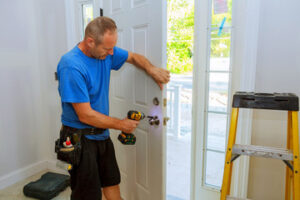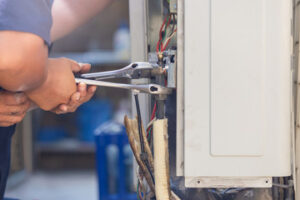Door Installation In Austin TX is a complicated task that requires experience. It involves installing something that must fit into an opening over a wall that is probably not plumb, level or square.

This type of installation takes more time than a pre-hung door but allows you to customize your look. Follow the installation instructions for your specific product to ensure warranty eligibility.
A door frame is a structure that supports a door. It is usually built into the wall, and it is important to have a strong frame so that the door can be secured properly. A good way to ensure a sturdy frame is by using galvanized nails, which are a type of nail that has a zinc coating and can help prevent corrosion and rust. You should also use a framing square to make sure your frame is square and level.
There are many different materials that can be used to build a door frame, including wood, aluminum, and steel. Each material has its own benefits and drawbacks, but wood is still a popular choice because it offers both durability and beauty. However, it is important to remember that a wooden frame may need more maintenance than other types of frames.
A doorframe is made of several components, including a head, jambs, and sill. The head is the horizontal piece that sets the width of the frame, and it often has grooves for the jambs to fit into. The jambs are vertical pieces that hold the hinges and latch. The sill is the bottom portion of the frame that sits on top of the doorway.
If you are installing a new exterior door, it is important to prepare the frame for the new installation before you start working on the door itself. To do this, measure the rough opening of the doorway. Then, cut two 2x4s to the length of your door frame. The longer piece will be called the king stud and will support the header. The shorter piece will be called the jack stud and will support the door jambs.
Jamb
The jamb is the vertical side of a door frame. It provides essential structural support, ensuring that the frame is properly aligned and secured within the wall opening. In addition, the jamb supports the locking mechanism of the door by providing a space for the latch and deadbolt to attach.
Door jambs are usually made of wood, but they can also be made of other materials such as fiberglass or aluminum. They may be smooth or rabbeted, depending on the type of door and wall. A smooth jamb is more convenient to install and may require less maintenance, while a rabbeted jamb is more suitable for a split-jamb interior door that needs a specific groove to house the door.
It is important to accurately measure the door jamb width before installing it, to ensure that the door fits correctly and doesn’t hit the wall or swing against it. To achieve this, it is recommended that you remove the casing and brick mould around the frame to visualize the gap between the studs. Once you have the measurements, you can cut the jamb pieces to size and secure them with screws or nails to the wall framing.
Lastly, it is recommended that you use high-quality jamb glue for best results. This type of glue is designed to withstand heavy loads and provide a long-lasting hold. Moreover, it is available in different formulas for indoor and outdoor applications.
A strong jamb is essential to a functional and secure door system, as it helps to prevent warm or cool air from leaking into your home, which can increase energy efficiency. If your door jamb is sagging, or you have issues with the lock or hinges, it’s important to repair it as soon as possible.
Sill
The sill of a window or door is the base that sits below the frame and serves as an anchor point. It also serves to help direct moisture away from the frame and prevent mold, rot, or structural issues. Sills can be made of a variety of materials, including wood, stone, and concrete. Each has its own advantages and disadvantages, depending on the type of building in which they are installed.
In stick framing, sills are typically constructed out of pressure-treated pine boards. They can be shaped to the design of the window or door and may be used to display planters, pictures, and other decor. In brick and historical structures, stone sills are common. They are durable, offer a classic look, and are resistant to moisture.
A good-quality sill is important to the integrity of a house or commercial structure. It is a critical load-bearing component and helps distribute the weight of the walls, windows, doors, and other components above it. Without a strong sill, the entire wall or foundation could become damaged or sag over time.
A solid sill is also important for energy efficiency. It creates a tight seal that helps keep out air drafts and cold temperatures, keeping the interior of the building comfortable and saving on heating and cooling costs.
Trim
Adding decorative trim to the top and sides of your door frame can be an easy way to give it a facelift. Whether you choose wood casing, urethane foam molding, or metal trim, it’s important to select a material that complements your home’s style. Once you’ve finished the trim, paint it a color that coordinates with your home for a cohesive look.
The trim of your exterior door can make or break the entire design. If you choose a trim material that doesn’t match the rest of your house, it will stand out like a sore thumb and draw attention to itself instead of blending in with the rest of your siding. In addition to enhancing the aesthetics of your home, trim also serves a functional purpose by covering the gap between your siding and the framing.
Before you begin trimming, be sure to remove any existing casing that might be in place. You’ll need to clean up any hard edges caused by residual wood glue and sanding, then make sure the new pieces of trim will align properly.
Next, determine how you’d like the pieces of casing to meet: Mitered trim connects with 45-degree angled joints, while butted ends fit together at a 90-degree angle. Both styles are available in a variety of flat or molded designs.
If you’re looking for a more traditional or rustic feel, opt for butted end trim. This design works well in rooms with lower ceilings, and painting the trim a contrasting color can visually elongate your walls. For a more contemporary look, consider using mitered casing on your doors. This style looks crisp and neat, and you can use a contrasting color to create an eye-catching focal point.
Hardware
Door hardware plays an essential role in a home’s design and functionality. It contributes to security, aesthetics and overall property value, and when properly installed, can help prevent damage. Upgrading your front door’s hardware is an easy way to improve security and give your home a fresh new look. It’s also a manageable do-it-yourself project that you can easily tackle on your own with a few tools and a bit of know-how.
Whether you’re looking to install an updated lockset or simply upgrade your current hardware, the first step is to understand what type of setup you currently have. From there, you can select a compatible replacement that fits your requirements and the existing installation. Then, you can follow the manufacturer’s instructions to ensure a secure and precise fit.
When purchasing door hardware, it’s important to consider sizing considerations, styles and finishes to ensure optimal function and a cohesive aesthetic throughout your living space. From durable hardware for exterior bifold doors to elegant doorknobs for interior doors, there’s a wide range of options available to suit your needs and budget.
The most commonly used type of door hardware is a lever or handle set with a latch and deadbolt. These types of hardware can be keyed to accept multiple keys or a single master key. It’s also important to note that not all hardware will work with all types of doors. Some require a specific backset and bore hole size, while others can be keyed to accept different key codes. It’s best to purchase hardware that is compatible with your door’s existing setup to avoid additional expenses and complications during installation.
